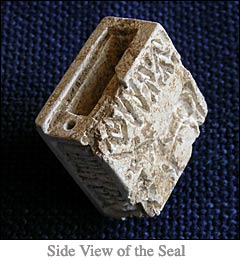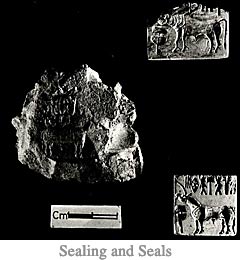Gola Dhoro Seals

Golo Dhoro being a very small site, we never expected to recover many Indus seals.
To our great surprise the site has revealed five inscribed steatite seals with one horned animal - usually referred as unicorn, with a standard device engraved in front of it.
The backs have prominently projecting pierced boss. Seals of this type are common in urban Harappan sites and most probably they may have been used in trade and exchange transactions by the Harappans. Stamped impression of such seals on a clay/terracotta sealing have also been found in the excavation.
 One of the steatite seals discovered this season has decorative linear patterns incised on three sides and a deep, scooped out rectangular socket-like cavity on the fourth side and originally it perhaps had a sliding lid to cover the socket. These are in addition to the usual engraved inscription and the unicorn figure on the seal and therefore it appears to be a unique one, since such seals with socket have not been reported from any other Harappan site so far.
One of the steatite seals discovered this season has decorative linear patterns incised on three sides and a deep, scooped out rectangular socket-like cavity on the fourth side and originally it perhaps had a sliding lid to cover the socket. These are in addition to the usual engraved inscription and the unicorn figure on the seal and therefore it appears to be a unique one, since such seals with socket have not been reported from any other Harappan site so far.
The gates of the fortification have been eluding us, but during last season's excavations we have been able to locate entrance to the fort on the southern side of the settlement. However during the next proposed excavation season, we would like to probe the eastern side of the fortification where we suspect that we may be able to find another entrance. Besides, we would like to reopen the shell working and stone bead making areas.
 Habitation at the site continued in the post-urban period too for another 200 years up to 1700 BCE. In the last phase there are indication that the trade activities and the production of various craft items, use of the fortification wall, writing and making steatite seals came to an abrupt end.
Habitation at the site continued in the post-urban period too for another 200 years up to 1700 BCE. In the last phase there are indication that the trade activities and the production of various craft items, use of the fortification wall, writing and making steatite seals came to an abrupt end.
Archaeologists studying the manufacturing techniques and artistic styles of the modern artisans are begging to reconstruct how the ancient artisans produced these striking objects. They also study some relationship between these crafts and traditional trading practices in order to understand better the economic organization of the ancient cities and towns. By combining the results of these craft studies with similar information on subsistence, archaeologists are now beginning to better understand the Harappan civilization. The detailed analysis of the excavated data of Gola Dhoro is hoped to help archaeologist to better understand this unique and one of the earliest civilization of the world.
